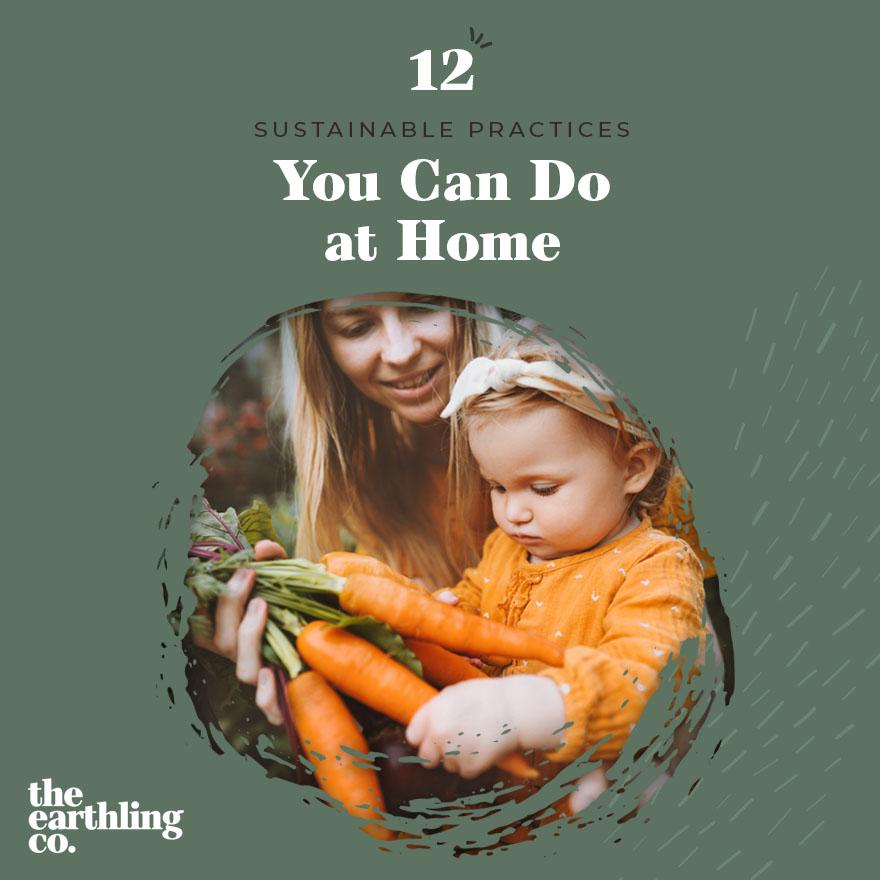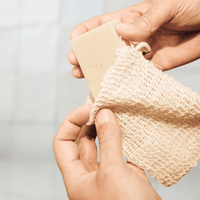
When we look at climate challenges on a global scale, it can seem like our daily actions are insignificant. But really, every choice we make matters. Each household in the United States drives up global greenhouse gas emissions through the use of energy, food, water, clothing and other resources. If we all took action to live more sustainably, imagine the impact we could have on the planet!
If you want to make this world a better place for you and future generations, adopting sustainability practices at home is a great place to start. Whether it’s planting a sustainable garden or switching to low-waste products, there are plenty of easy steps you can take to reduce your carbon footprint and live a more sustainable lifestyle.
So, are you with us? Keep reading for 12 sustainability practices you can do at home.
1. Avoid Disposable Items
Disposable items, while convenient, are terrible for the environment. On-the-go coffee cups, plastic bottles, takeout utensils and other single-use products generate an enormous amount of waste and require a lot of resources to produce, manufacture and recycle.
So, what can you do to help? Start by replacing your most commonly-used disposable items with reusable versions. Here are a few of our recommendations:
![]()
- Swap single-use cotton rounds and makeup wipes with reusable cotton rounds.
- Swap disposable plastic straws with easy-to-clean stainless steel straws.
- Swap paper napkins with cloth napkins.
- Swap to-go coffee cups with reusable coffee mugs.
- Swap plastic wrap with reusable silicone bowl covers.
These simple swaps are easy to make and will go a long way in reducing your impact on the environment. Another benefit to switching to reusables? They’ll help you pocket more money in the long run!

2. Reduce Your Food Waste
Did you know that it takes up to 25 years for a head of lettuce to decompose in a landfill? When our organic waste gets dumped in a landfill, it breaks down anaerobically (meaning, without oxygen) and releases methane, a gas that is 80 times more powerful than carbon dioxide. Some ways to reduce your food waste include:
- Check the contents of your refrigerator and pantry before you shop.
- Make a grocery list and stick to it. If you’re shopping for multiple family members, consider using a shared grocery app like AnyList or Out of Milk to avoid buying duplicates.
- Buy foods that are in season. (Seasonal produce tastes better and doesn’t go bad as quickly.)
- Repurpose food scraps (e.g., use citrus peels to make a DIY household cleaner).
- If you make too much food, pack up your leftovers in reusable containers.
- Freeze your leftovers before they go bad.
3. Make Your Own Cleaning Products
Most cleaning products come packaged in plastic and contain a slew of controversial ingredients that are potentially harmful to your health and the environment. Ammonia, for example, has been linked to all sorts of adverse health reactions and is a major source of nitrogen pollution.
Instead of disinfecting your home with toxic chemicals, consider making your own low-waste cleaning supplies at home. Vinegar is a great cleaner for most surfaces (avoid marble and limestone) and smells much better when infused with citrus peels.
Instructions:
- Fill a Mason jar with vinegar about two-thirds of the way full.
- Add citrus peels and let them infuse for three to four weeks.
- Strain out the citrus peels and fill a spray bottle with one part water, one part citrus-infused vinegar.
4. Grow a Sustainable Garden
Commercial farming usually involves a ton of pesticides and synthetic fertilizers, which aren’t good for our health or the planet. Why not grow your own food instead? With a backyard garden, you have complete control over what goes on your plants and into the soil.
Growing your own plants is easy, rewarding and a great way to reduce your carbon footprint. Commercially-grown produce often travels thousands of miles to reach your plate, whereas the produce you grow in your backyard travels zero miles.
Don’t have a backyard to grow your own food? Container gardens are great for apartment-dwellers and other small spaces. If that isn’t an option, consider joining a community garden.

5. Buy Products with Less Packaging
We’ve all heard the scary statistics about plastic, like how there will be more plastic than fish in our oceans by 2050. But did you know that product packaging is a major contributor to plastic waste? In fact, about 40 percent of all plastic produced is packaging, according to National Geographic.
A simple step you can take to reduce your packaging waste is by opting for sustainable products with plastic-free packaging, such as shampoo bars (and conditioner bars). These nutrient-dense bars are great for all hair types and are super low waste, replacing two to three plastic bottles that would otherwise go to a landfill. Plus, they don’t contain harmful ingredients that get into our waterways when they go down the drain.

Here are a few additional ways to reduce your packaging waste:
- Shop the bulk bins at your local grocery store and bring your own container.
- Shop plastic-free at the farmers market.
- Buy products that have compostable or reusable packaging.
- Make your own DIY products to save money and the planet.
- Limit takeout and food delivery for special occasions.
6. Recycle Properly
Many people don’t realize the importance of recycling. Beyond reducing the amount of waste sent to landfills, recycling prevents pollution, saves energy and helps in the conservation of valuable resources. But if you’re tossing items into a recycling bin without checking if they can actually be recycled (aka, “wishcycling”), you could be doing our planet more harm than good.
When you throw paper coffee cups, grease-stained pizza boxes and other items that can’t be recycled into the recycling bin, it contaminates the system and forces recyclers to send the entire load of recyclables to landfills or incinerators. Here are our recommendations to avoid wishcycling:
- Learn about the basics of recycling from the EPA.
- Check with your local recycling program to see which items they accept.
- Sort through your recycle bin to ensure that items aren’t contaminated.
- Educate your friends and family on how to recycle properly.
- Whenever possible, compost your organic materials!

7. Take Meat Off the Menu
Taking meat off the menu is one of the best things you can do for the environment. In fact, a recent study found that if Americans ate a plant-based diet 50 percent of the time, we could reduce diet-related greenhouse gas emissions by 35 percent.
Besides, eating more plant-based foods is associated with a bevy of health benefits, from better gut health to lower risks of cardiovascular disease. And with food scientists continuing to find ways to create healthier, better-tasting plant-based foods, going vegan (or vegetarian) has never been easier. Here are some tips to help you kickstart your plant-based journey:
- If you come from a meat-loving family, start small by taking meat off the menu one to two nights a week.
- When you decide to eat meat, shrink your portions.
- Follow vegan Instagram accounts for delicious, plant-based meal ideas.
- Keep your meals fun and exciting! Challenge yourself to learn new vegan recipes and try an assortment of plant-based products.
8. Buy Less, Buy Better
Our spending habits can have a devastating effect on the planet and its inhabitants. Indeed, most people inadvertently support companies that contribute to plastic pollution, habitat destruction, animal cruelty and unfair wages. Here are some ways you can become a more conscious consumer and start voting with your dollars:
- Think before you buy. Do you really need that item? Or do you just want it because it’s shiny and new?
- Reduce your consumption and waste by choosing multipurpose items (e.g., a cream blush that doubles as a lipstick).
- Buy from brands that support sustainability and ethical behavior.
- Invest in pieces that are made to last.
- Embrace a little minimalism.
- Shop secondhand.

9. Be Water Wise
It’s easy to take water for granted, especially when you don’t live in a drought-stricken region. But water is more precious than you might think. Although the amount of water on Earth will always be the same, our access to it can vary depending on the different stages of the water cycle. Here are a few easy, water-saving strategies you can use at home:
- Check for leaks regularly and get them fixed ASAP.
- Install low-flow showerheads, dual-flush toilets and other water-saving fixtures in your home.
- Take a shorter shower. According to the EPA, we could save 170 billion gallons of water each year if every person in the United States reduced their shower time by one minute.
- Skip the bottled water (and the plastic) by drinking tap water instead.
- Collect grey water from sinks, showers and other non-toilet drains and use it to water your plants.
10. Shop Local and Support Small Businesses
From putting money back into your community to helping create jobs, there are plenty of reasons to shop local. And here’s one more to add to the list: Shopping locally is good for the environment! Local businesses often have a smaller footprint than big box stores because their products are more likely to be locally sourced, reducing both packaging waste and the number of miles the product has to travel to reach your doorstep.
Obviously, buying from local and small businesses is one of the best ways to support them. However, if you want to support small businesses without making any unnecessary purchases, here are a few ideas to get you started:
- Like and share their posts on social media.
- Support them in their community efforts.
- Show up to events and milestone celebrations.
- Spread the word about them to friends and family.
- Write them a positive review.

11. Reduce Your Energy Use
Reducing your home energy use not only lowers your utility bill, but it also benefits the environment. By conserving energy, we can limit the number of greenhouse gases (GHG) that are emitted into our atmosphere, which means less smog and air pollution. Here are a few ways to conserve energy at home:
- Replace old appliances with energy-efficient models.
- Unplug your devices when not in use.
- Switch to an energy provider that uses renewable energy.
- Replace your light bulbs with energy-efficient LEDs.
- Wash your clothes in cold water. (It’s better for your clothes, anyway.)
12. Go Car-Free
Have you ever stopped to think about the environmental impact of your car? According to the EPA, the typical passenger vehicle spits out an estimated 4.6 metric tons of carbon dioxide annually.
Less driving means fewer emissions going into the atmosphere. Here are some ways you can decrease your transportation footprint:
- Walk or ride a bicycle whenever possible.
- When running errands, try to hit all of your stops in one trip.
- Take public transportation.
- Consider using ride-sharing services.
- Work remotely when possible.
Every Step Counts

Individual efforts to sustainability may seem like tiny contributions to the huge problem of climate change, but every action makes a difference. Collectively, we have the power to spark real change and make a positive impact on our beautiful planet.
Want to help us create a more harmonious world? Shop the entire collection of low-waste products at The Earthing Co. and read our blog for more tips and tricks on how to live more sustainably.
Image Credits
everst/Shutterstock.com
nevodka/Shutterstock.com
Markus Mainka/Shutterstock.com
Kingkarn Mala/Shutterstock.com
Alix Kreil/Shutterstock.com
Dmitry Vinogradov/Shutterstock.com
AYA images/Shutterstock.com
Romanova Ekaterina/Shutterstock.com





